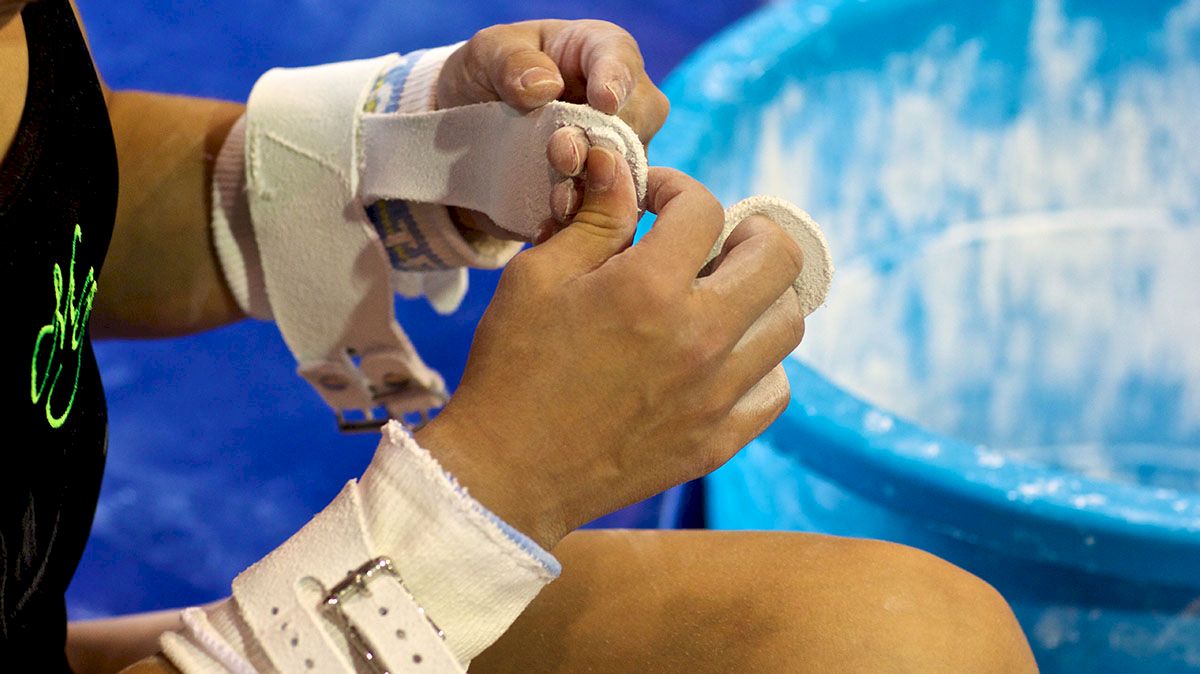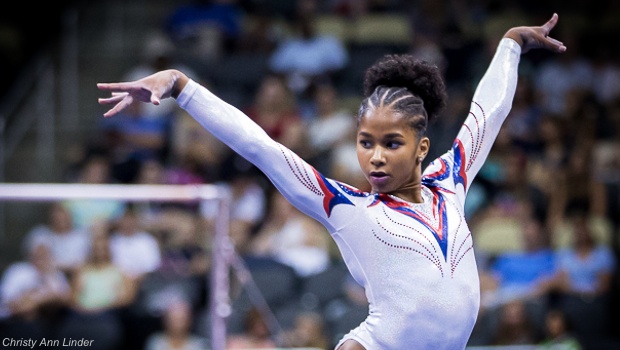Understanding the E-score in Elite Gymnastics: Floor Exercise
Understanding the E-score in Elite Gymnastics: Floor Exercise


In our last part of our series on understanding the E-score in elite gymnastics, we’re focusing on floor exercise, arguably one of the toughest events to minimize deductions on. As a reminder, our summary below is for deductions specific to the apparatus. There are other deductions that the judges may take which are considered “general faults and penalties.” The general faults are things like bent arms/knees, legs crossed during a twisting element, and flexed feet. Landing issues are also included under general faults and include legs apart on landing. Most of the general faults will result in deductions of 0.10 or 0.30, with the exception of landing deductions which can be as much as 0.80.
Check out our summary of specific floor exercise deductions below.
Artistry of Performance
Unsurprisingly, artistry is a very important aspect of a floor routine. The Code of Points describes the main objective of a floor routine as being “to create and present a unique and well-balanced artistic gymnastic composition by combining the body movements and expression of the gymnast harmoniously with the theme and character of the music.” As on balance beam, the gymnast is expected to construct a continuously flowing routine, rather than showcasing disconnected elements.
Deductions can be taken for insufficient artistry, which consists of anything from personality to confidence to expressiveness, and the gymnast can get up to 0.30 points off in deductions for this. Additional tenths can be taken for “inability to play a role or character throughout the performance” and if there is lack of flow throughout the routine. Expression is also important, referring to how the gymnast connects to the public, how her facial expression and movements connect to the music, plus “artistic harmony and feminine grace.”
Composition & Choreography
As always, the judges like to see variety in the routine, to include movements high and low on the floor, change of direction in skills, and creative movements and connections. A tenth can also be taken if the gymnast does not make use of the entire floor. A gymnast’s choice of music is also important and must match up well with the her personality and style. Deductions of up to 0.30 can be taken for a weak relationship between the music and the gymnast’s movements.
Another important composition requirement is a full turn. While the other composition requirements, such as a leap series, are covered under the D-score, the full turn is covered under the E-score. Missing the minimum of a full turn on 1 foot would result in a 0.30 deduction.
Timing of the exercise is the same as on balance beam - 1 minute 30 seconds. A tenth can be taken off for finishing after the music.
Music & Musicality
As previously noted, a gymnast’s music selection is very important and the judges will pay attention to how well it matches the composition of the routine. Beyond that, the gymnast must show that she is able to follow the rhythm and beats of the music - inability to do so can result in up to 0.30 in deductions. The gymnast is also expected to match her last move to the last beat of the music, or she will receive a 0.10 deduction. “Background music”, defined as when the routine is connected to the music only at the beginning and end, would receive a 0.50 deduction. Music with words is a big no-no and will receive a full point in deductions, however music can contain human voice as long as the sounds made “hold no meaning” such as chanting, humming, whistling, etc.
Skill Errors
In addition to the general faults, such as a gymnast crossing her legs on a twisting element or flexing her feet, there are a few other faults specific to floor that can result in deductions. One common deduction relates to the moments before a gymnast tumbles. Standing in more than one stationary position on two feet will result in a tenth off, as well excessive pause (defined as 2 seconds) before a tumbling run. Poor body posture throughout the routine can get up to 0.30 in deductions.
Many deductions will come from landings. Taking a step or landing out with 1 foot or hand out of bounds will receive 0.10 off. Landing with both feet or hands out of bounds, stepping with both feet out of bounds, or landing with another body part out of bounds receives 0.30 in deductions.
That concludes our series on understanding the E-score in elite gymnastics. We hope you’ve found it useful!
Related:
Understanding the E-score in Elite Gymnastics: Balance Beam
Understanding the E-score in Elite Gymnastics: Uneven Bars
Understanding the E-Score in Elite Gymnastics: Vault
Elite Vaulting: The D-Score Explained
Crafting a Bars Routine: An Analysis of the D-Score
Crafting a Floor Routine: An Analysis of the D-Score
Crafting a Beam Routine: An Analysis of the D-Score